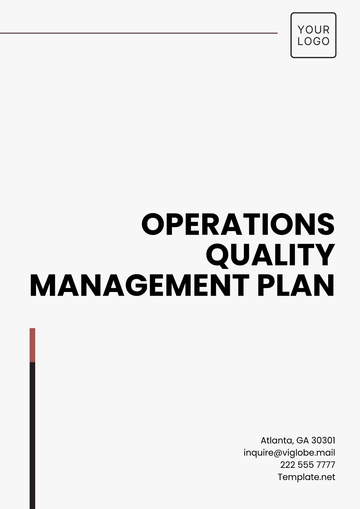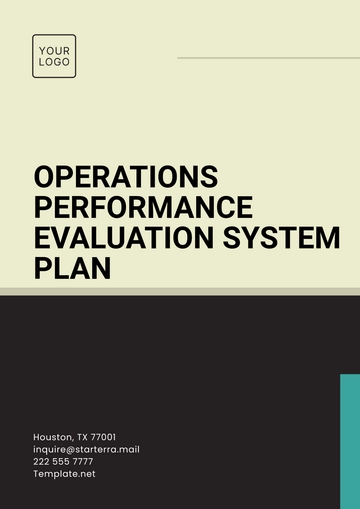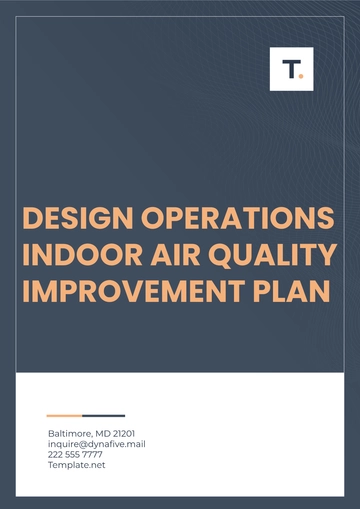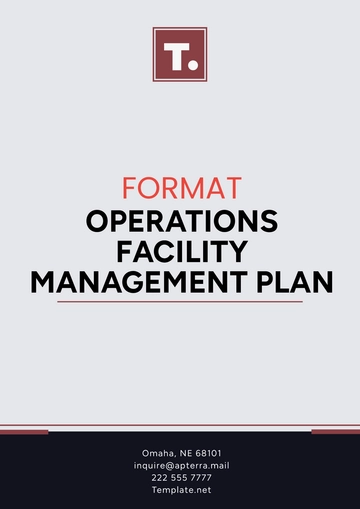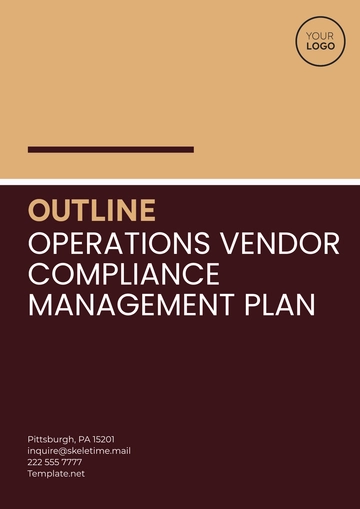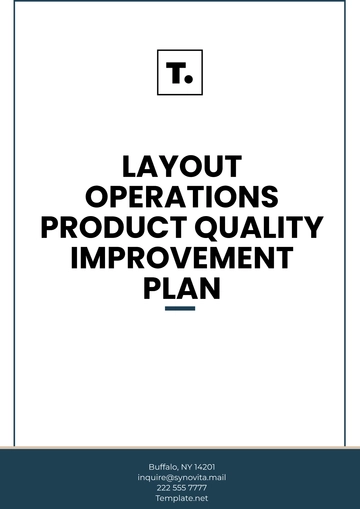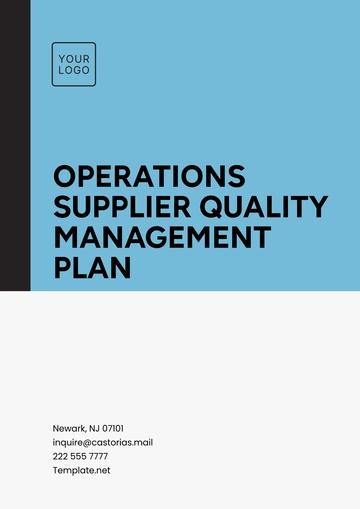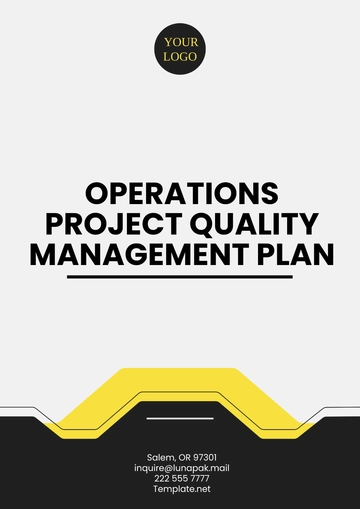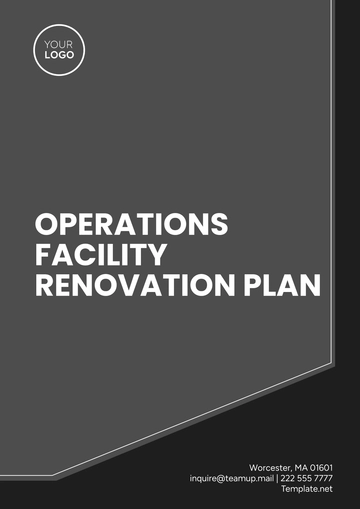Free Design Operations Indoor Air Quality Improvement Plan

Prepared By: | [Your Name] |
Company: | [Your Company Name] |
Date: | [Date] |
Introduction
Indoor air quality (IAQ) is a critical factor in the health, comfort, and productivity of occupants in any building or facility. In design operations, ensuring that the air quality remains at optimal levels is crucial not only for the well-being of the individuals inside but also for the longevity of the building’s infrastructure. This plan outlines the strategies, actions, and technologies that will be employed to improve indoor air quality in design operations environments. The goal is to create a healthier, more sustainable indoor environment that aligns with best practices and complies with regulatory standards.
Objectives
The primary objectives of this Indoor Air Quality Improvement Plan are:
Enhance occupant health and comfort by improving the air quality within design operations spaces.
Minimize exposure to harmful pollutants that can adversely affect respiratory health.
Ensure compliance with local, national, and international indoor air quality standards.
Promote sustainability through the use of eco-friendly materials and energy-efficient technologies.
Increase productivity by improving the overall air quality, leading to better focus and reduced absenteeism due to health issues.
Key Components
1. Assessment of Current Air Quality
A thorough evaluation of the existing indoor air quality will be carried out. This assessment will include:
Measurement of common pollutants such as particulate matter (PM), volatile organic compounds (VOCs), carbon dioxide (CO2), and formaldehyde.
Evaluation of ventilation systems, including airflow rates and the effectiveness of filtration systems.
Identification of potential sources of contamination such as mold, asbestos, or tobacco smoke.
2. Ventilation System Enhancement
The ventilation system plays a crucial role in maintaining good IAQ. The plan will focus on:
Increasing fresh air intake by upgrading HVAC (heating, ventilation, and air conditioning) systems to ensure a consistent flow of outdoor air.
Regular maintenance of HVAC systems to prevent mold, dust, and other contaminants from circulating within the building.
Upgrading filters to higher-grade HEPA (high-efficiency particulate air) filters, which can capture smaller particles and pollutants.
Optimizing air circulation by adjusting air distribution methods to ensure uniform air quality throughout the space.
3. Use of Air Purification Technology
In addition to improving ventilation, air purifiers will be installed in critical areas such as meeting rooms, open offices, and common spaces to further enhance air quality. These units will:
Remove particulate matter, allergens, and other harmful particles from the air.
Be equipped with UV-C light technology to neutralize harmful microorganisms like bacteria and viruses.
Be regularly maintained to ensure maximum efficiency.
4. Sustainable Materials Selection
One of the significant contributors to poor IAQ can be the off-gassing of harmful chemicals from building materials, furniture, and paints. This plan emphasizes:
Choosing low-VOC and non-toxic materials for construction, design, and furnishing.
Opting for sustainable and eco-friendly building materials, such as bamboo flooring, recycled content materials, and non-toxic paints.
Encouraging the use of plants that help purify the air naturally and enhance aesthetic appeal.
5. Indoor Pollutant Management
Efforts will be made to limit the introduction of indoor pollutants by:
Implementing a no-smoking policy within and around the building.
Encouraging the use of non-toxic cleaning products that are free from harmful chemicals.
Regular monitoring and cleaning of air ducts and other potential sources of pollution such as carpets and upholstery.
6. Employee Awareness and Engagement
Promoting awareness and encouraging active participation is crucial to the success of this plan. Actions include:
Providing training sessions for employees on the importance of indoor air quality and ways they can contribute to maintaining it.
Encouraging the use of natural ventilation when possible (e.g., opening windows) during favorable weather conditions.
Creating a feedback system to monitor the effectiveness of the implemented measures and suggest improvements.
Action Plan and Timeline
Action | Responsible Party | Timeline | Expected Outcome |
|---|---|---|---|
Conduct IAQ assessment | Facility Manager | 1 month | Baseline IAQ data for improvement initiatives |
Upgrade HVAC and ventilation systems | Operations Team | 2 months | Enhanced airflow and pollutant removal |
Install air purifiers in high-traffic areas | Environmental Services | 3 months | Reduced particulate matter and contaminants |
Choose sustainable materials for renovations | Design Team | 4 months | Healthier, non-toxic indoor environment |
Implement employee training sessions | HR Department | 2 months | Increased awareness of IAQ practices |
Establish ongoing IAQ monitoring system | Facilities and Maintenance | 6 months and ongoing | Continuous monitoring and quality assurance |
Monitoring and Review
Regular monitoring will be conducted to assess the effectiveness of the strategies. IAQ measurements will be taken quarterly to ensure pollutant levels remain below acceptable thresholds. Additionally, feedback will be collected from employees regarding their perceptions of air quality and any potential concerns. Any necessary adjustments to the plan will be made based on this data.
Conclusion
This Indoor Air Quality Improvement Plan for design operations aims to create a healthier and more productive indoor environment. By enhancing ventilation, utilizing air purification technologies, selecting sustainable materials, and involving employees in maintaining air quality, the goal is to provide a safe, comfortable, and sustainable workspace. Continuous monitoring and improvement will ensure the long-term success of this initiative, benefiting both employees and the organization as a whole.
- 100% Customizable, free editor
- Access 1 Million+ Templates, photo’s & graphics
- Download or share as a template
- Click and replace photos, graphics, text, backgrounds
- Resize, crop, AI write & more
- Access advanced editor
Prioritize a healthy work environment with this customizable Operations Indoor Air Quality Improvement Plan Template, available exclusively on Template.net! This editable plan ensures a convenient approach to enhancing indoor air quality. Supporting employee well-being and regulatory compliance now made easier with our user-friendly AI Editor Tool! Try it out today!
You may also like
- Finance Plan
- Construction Plan
- Sales Plan
- Development Plan
- Career Plan
- Budget Plan
- HR Plan
- Education Plan
- Transition Plan
- Work Plan
- Training Plan
- Communication Plan
- Operation Plan
- Health And Safety Plan
- Strategy Plan
- Professional Development Plan
- Advertising Plan
- Risk Management Plan
- Restaurant Plan
- School Plan
- Nursing Home Patient Care Plan
- Nursing Care Plan
- Plan Event
- Startup Plan
- Social Media Plan
- Staffing Plan
- Annual Plan
- Content Plan
- Payment Plan
- Implementation Plan
- Hotel Plan
- Workout Plan
- Accounting Plan
- Campaign Plan
- Essay Plan
- 30 60 90 Day Plan
- Research Plan
- Recruitment Plan
- 90 Day Plan
- Quarterly Plan
- Emergency Plan
- 5 Year Plan
- Gym Plan
- Personal Plan
- IT and Software Plan
- Treatment Plan
- Real Estate Plan
- Law Firm Plan
- Healthcare Plan
- Improvement Plan
- Media Plan
- 5 Year Business Plan
- Learning Plan
- Marketing Campaign Plan
- Travel Agency Plan
- Cleaning Services Plan
- Interior Design Plan
- Performance Plan
- PR Plan
- Birth Plan
- Life Plan
- SEO Plan
- Disaster Recovery Plan
- Continuity Plan
- Launch Plan
- Legal Plan
- Behavior Plan
- Performance Improvement Plan
- Salon Plan
- Security Plan
- Security Management Plan
- Employee Development Plan
- Quality Plan
- Service Improvement Plan
- Growth Plan
- Incident Response Plan
- Basketball Plan
- Emergency Action Plan
- Product Launch Plan
- Spa Plan
- Employee Training Plan
- Data Analysis Plan
- Employee Action Plan
- Territory Plan
- Audit Plan
- Classroom Plan
- Activity Plan
- Parenting Plan
- Care Plan
- Project Execution Plan
- Exercise Plan
- Internship Plan
- Software Development Plan
- Continuous Improvement Plan
- Leave Plan
- 90 Day Sales Plan
- Advertising Agency Plan
- Employee Transition Plan
- Smart Action Plan
- Workplace Safety Plan
- Behavior Change Plan
- Contingency Plan
- Continuity of Operations Plan
- Health Plan
- Quality Control Plan
- Self Plan
- Sports Development Plan
- Change Management Plan
- Ecommerce Plan
- Personal Financial Plan
- Process Improvement Plan
- 30-60-90 Day Sales Plan
- Crisis Management Plan
- Engagement Plan
- Execution Plan
- Pandemic Plan
- Quality Assurance Plan
- Service Continuity Plan
- Agile Project Plan
- Fundraising Plan
- Job Transition Plan
- Asset Maintenance Plan
- Maintenance Plan
- Software Test Plan
- Staff Training and Development Plan
- 3 Year Plan
- Brand Activation Plan
- Release Plan
- Resource Plan
- Risk Mitigation Plan
- Teacher Plan
- 30 60 90 Day Plan for New Manager
- Food Safety Plan
- Food Truck Plan
- Hiring Plan
- Quality Management Plan
- Wellness Plan
- Behavior Intervention Plan
- Bonus Plan
- Investment Plan
- Maternity Leave Plan
- Pandemic Response Plan
- Succession Planning
- Coaching Plan
- Configuration Management Plan
- Remote Work Plan
- Self Care Plan
- Teaching Plan
- 100-Day Plan
- HACCP Plan
- Student Plan
- Sustainability Plan
- 30 60 90 Day Plan for Interview
- Access Plan
- Site Specific Safety Plan


